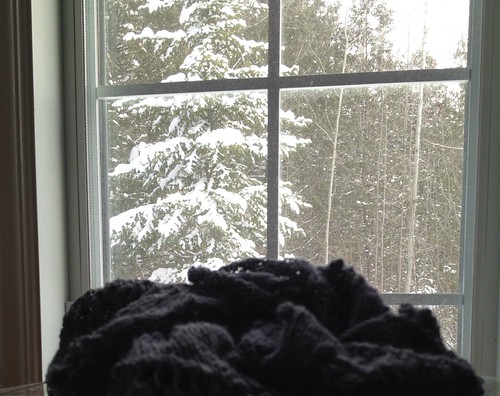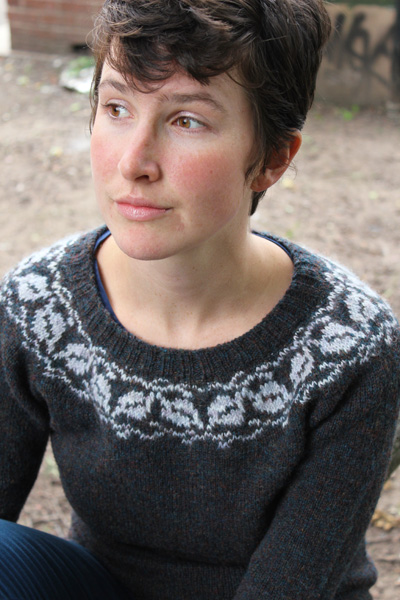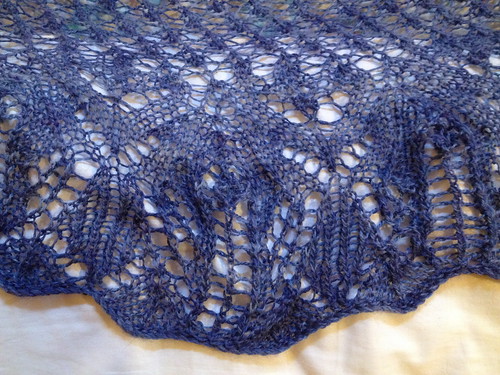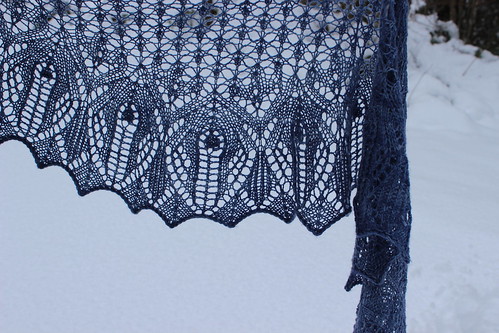…of a White Christmas.
I think we’re pretty well guaranteed that that will happen. While we are currently in a warm spell (with temperatures up to all of -6C today), we’re just coming off more than a week of sub -20C. It’s really pretty outside, and it’s a great time to sit by the fireplace and admire the glistening snow on the spruces.

The Indie-Gift-A-Long (GAL) running during November and December consists of 177 independent designers banding together to offer you wonderful patterns. The GAL is already well under way, and there are lots of lovely projects being knit up and displayed in the Ravelry Group. If you’re not already there, go check it out. There are lots of opportunities to win all sorts of prizes, and aside from that, it’s great fun to see what others are knitting.
Part of the fun of the GAL is to get to discover designers and you may have not yet heard of. So on that note, I have been talking to Mirella of Wool + Bricks.
When did you start to design things?
Like many people, I started out modifying patterns because I wanted something specific and couldn’t find a pattern for it. I started drawing my own charts a few weeks after learning to knit, then calculated and made my own pattern for chevron fingerless mitts within a few months, so my knitting was fairly intrepid from the early days. Yet I remember feeling blown away by the discovery that a woman in my knitting group in Glasgow had knitted her cardigan without using a pattern. As a brand-new knitter it seemed like the impossible!
What would you say have been the big challenges in designing and releasing patterns?
There are new challenges at every turn, but there are some constants: the big one in my decision-making process is always sizing, while the big one in my production process is software.
Regarding sizing, I try to be as inclusive as possible in the sizes I make my garments available in and there are limitations to how well I can get the same design to fit in at both ends of the sizing scale. There can be days of sheer frustration when working on a particular construction that just doesn’t grade neatly into some sizes.
As for software, I try and keep my business open-source, using free programs for the production process of my self-published patterns. Most other open-source users will understand when I mention how long-winded some programs makes the simplest tasks! What makes things worse is that I have experience of using Adobe CS and I know how streamlined it can be for the same tasks I’m wrestling with Scribus to perform. But it’s an ideology thing. I like to imagine that one day open-source will be the pinnacle of both hardware and software technology, so I need to be the change I want to see.
Do you have a favourite type of item to knit?
I’m fairly obsessed with yoked sweaters, particularly the style of Bohus Stickning. This comes in hand with my obsession with Scandinavian indie pop throughout my teen years and student days, and my obsession with Scandi-drama TV series that developed fairly recently (alongside obsessive sweater-knitting, of course!). One of my first knitting books was Sheila McGregor’s Complete Book of Traditional Scandinavian Knitting, and one of my most-recent purchases was Mary Mucklestone’s 150 Scandinavian Knitting Designs, the second-ever sweater I started knitting was Kate Davies’ Paper Dolls, and the last pattern I followed was Létt-Lopi Vest by Védís Jónsdóttir. It’s fair to say this is a prolonged obsession!
Are you more of a process knitter or a product knitter?
I’m a dialectic knitter! (For anyone who hasn’t seen Ryan Gosling’s brilliant explanation of dialectics in Half Nelson, you can watch a montage of it on YouTube:http://youtu.be/t1Lo3P-Dp4Y).
I look at a cool technique or interesting texture and think “I have to learn how to do that”, but I’m also fixated on the functionality of objects and don’t really have things in my life that I can’t use, so there’s an antagonism there between “beautiful” and “useful”. I have to find a way to incorporate cool or interesting with useful or functional. And, inevitably, my synthesis is colourwork yokes! Well, of course there are other items, but there’s a lot of colourwork-sections-on-a-stockinette-background…
I notice you’ve released a few sweater patterns, including Whiteleaf in the recent issue of Knitty. What was your inspiration?
I designed the entire sweater around the handspun yarn I used for the yoke contrast colour. No joke! It had a definite character to it and was very evocative of a time and place, so I worked about 20 charts and swatches of various leafy concepts until I had it. Then the sweater was constructed around the sort of use I anticipated it getting with a cold-weather, outdoorsy yoke design: slightly deeper armholes for additional layering, longer length to keep warmth in, snug cuffs and hem with 2×2 ribbing. It’s definitely a sweater to be worn over thermals on days when the air has a snap to it.

How you chose which sizes in which to offer it, and do you have any thoughts on the grading process?
I’ve thought about sizing for as long as I’ve thought about writing garment patterns. To be honest, it was one of the things that held me back for a long time. I know the data for the smallest and largest sizes is a bit shaky and I am still not confident of the proportioning in the standard measurements, but we have to use the tools available to us!
I decided to write my garment patterns in the widest range of sizes I feel competent grading to, so you’ll find my earlier patterns don’t accommodate such a wide range of sizes as my more recent ones. At some point I hope to go back and up-grade (ha!) these.
I begin grading at the start of the design process, and the grading-design-grading is a feedback loop that sometimes takes way longer than I’d hope. I feel it’s important to spend time on every question mark, because nobody should feel their size was insignificant to the designer. Every time someone knits one of the sizes I am newer to grading for (and is happy with the fit) that spurs me on to continue pushing those boundaries.
With Whiteleaf, I felt confident combining the design elements and construction into a range of sizes that I felt was inclusive. Having spoken to designers who do cover a wider range of sizes, it was clear that there are knitters out there who love it when patterns are published in their size range. Every single grading frustration I faced was worked through with these knitters in mind, and I really hope I did alright.
How did the GAL go for you? What did you like about it (if you did)?
I love the sense of coming together. Most of us work independently on our designs, in our homes or studios, and our only contact with other people doing the same thing is on Ravelry (I know there are pockets of designers who meet in real life and encourage each other in nurturing communities, but they’re the lucky ones!). The GAL recognised this and turned it into the basis for a collaboration. We used our existing marketplace and products, and medium we communicated through, to create an entirely new form of marketing. It was really exciting in the early stages, watching the ideas foment in front of my eyes, and seeing new relationships forming.
What were your most popular patterns?
Laddow was my most popular pattern during (and since) the GAL promotional period, with Amina coming second. Both are slightly tricky colourwork projects, which are a personal favourite, so I’m really pleased there is demand for this type of pattern.
Would you participate again?
I will definitely participate in future, although I feel the project will always be of greatest benefit to those most able to use social media for both individual and collective promotion. Being hugely Facebook-averse, there’s a limit to how much I can contribute, but I’ll offer what I can and hopefully it will be enough!
What’s next for you?
I’m trying hard not to over-commit to all the exciting opportunities that appear all over this field, because it feels like the market is still expanding and the demand is ever-growing but I’m an economic cynic and keep expecting to wake up one morning to discover a bubble has burst!
On a more positive note, I’m venturing into menswear design for the next couple of months, with some more women’s garments in the pipeline, too. Some collaborations, some publications, a rich mix of everything. It’s a good place to be!
If you would like to win a copy of one of Mirella’s patterns, leave a comment with the name of the pattern you would like to win before midnight on Dec 26, 2013. I will select a winner (by random number generator) on Dec 27.
The winner from last week’s interview was lmecoll. Congratulations Linda! The pattern will be sent your way by Sarah as soon as possible.
A whole lot of us indie designers on Ravelry are banding together for an Indie-Gift-A-Long (GAL) running during November and December. It’s already well under way, and there are lots of lovely projects being knit up and displayed in the Ravelry Group. If you’re not already there, go check it out. There are lots of opportunities to win all sorts of prizes, and aside from that, it’s great fun to see what other’s are knitting.
One of the other participating designers is Sarah Ronchetti. Sarah has a number of lovely designs in her Ravelry store including hats, mitts, socks and sweaters. I had the chance to ask her a couple of questions about her designs. I rather like the Waihi Socks.
Why do you like designing socks?
I have always loved knitting socks, I love wearing hand knit socks, and I think they make great gifts for others as well as for personal knitting. I love that they can be fairly fast knits, they are practical and you can combine stitch patterns in ways that you wouldn’t on garments. I also have large(long) feet, and finding well fitting bought socks is not always possible.
I am inspired by lots of different things, often the colour of a particular skein is the jump off point, although my designs do tend to change from imagination to needles.
How do you decide what sizes to offer your patterns in?
It really depends on the stitch pattern I am working with and the sizes are sometimes limited by that. I try and do at least 3 woman’s sizes for a feminine pattern, knowing that the women in my family alone would need those different sizes.
I enjoy the grading process of socks, I’ve recently created a few formulas that are working for me in writing up the patterns and that seems to be saving me some time.
How has your GAL experience been?
I’ve really enjoyed the GAL – My most popular patterns have been Alec and Alec XL, but its been lovely to see my Hutt Valley Hat and Mitts which have been fairly quiet, be knit up and loved!
What’s next for you?
More socks! I have a new sock pattern coming out next week, and a few more lined up for the new year as well!
If you would like to win a copy of one of Sarah’s patterns, please leave a comment on this post with the name of the pattern you would like to win before midnight on Dec 18, 2013. I will select a winner (by random number generator) on Dec 19.
Every lace shawl pattern will finish with the instructions to block your shawl. And we all know that it’s important. But just how important is it? Let’s take a look.
This is The Little Match Girl from Fairy Tale Lace fresh off the needles.

Yarn has memory, and at this point the yarn remembers what it was like to be in a ball of yarn. When you knit it, it has not yet learned the shape of the stitches, and therefore tries to straighten out a bit and then curl back into a ball. This leads to the stitches looking a bit distorted.
If you soak the shawl, the yarn forgets its previous shape, and remembers where it dries. So to block it, make sure that the fibers are soaked thoroughly (this will take about 15 minutes). Then remove the shawl from the water and squeeze out as much water as you can. Remember that you are working with a delicate lace shawl, so don’t wring it aggressively or anything, but squeeze.
Then lay it on a flat surface and pin it out into shape. This will open up the lace like this:

I tend to block fairly hard and stretch out the fabric as much as possible. This leads to a very open look for the lace.
When the fabric dries, the yarn will now be “set” and will remember its new shape. It will be open, lacy and beautifully delicate.

The shawl should retain its blocked look until it gets wet again. Any amount of water, even slight dampness,] or just moisture from the air will cause it to relax over time. But most shawls, if handled cautiously, like any fine clothing, do not need to be re-blocked very often.

 These fingerless gloves feature a fitted thumb gusset, and Estonian lace patterns. Inspired by waves that spread across a pond or even an ocean, they take their name from Capillary waves, or ripples. The cuff has lace patterning all around.
These fingerless gloves feature a fitted thumb gusset, and Estonian lace patterns. Inspired by waves that spread across a pond or even an ocean, they take their name from Capillary waves, or ripples. The cuff has lace patterning all around.
 They were originally knit in Skinny Bugga! from the Sanguine Gryphon (red), but I think they look quite fabulous in their re-knit form in Eidos from the Verdant Gryphon (yellow). I released them as a part of an e-book, called Seven Fingerless Mittens, which contains seven fingerless mitten patterns in different style. The Capillary gloves are lacy, but there are also patterns with cables, slipped stitches, and just plain knits-and-purls.
They were originally knit in Skinny Bugga! from the Sanguine Gryphon (red), but I think they look quite fabulous in their re-knit form in Eidos from the Verdant Gryphon (yellow). I released them as a part of an e-book, called Seven Fingerless Mittens, which contains seven fingerless mitten patterns in different style. The Capillary gloves are lacy, but there are also patterns with cables, slipped stitches, and just plain knits-and-purls.
To celebrate this new look for the Capillary, the pattern is discounted $2 until Dec 10, 2013 (23.59 PM EST).
If you would rather purchase the full e-book with Seven Fingerless Mittens, it is discounted by $3 during this same time-period.
Use the coupon code ripples during checkout. The pattern (and e-book) is available here.
(The same coupon code works for both the single pattern and the e-book).



Recent Comments